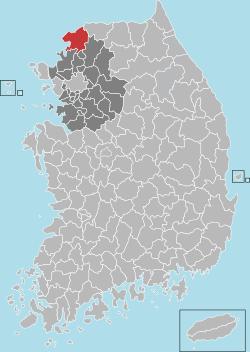Yeoncheon County
| Yeoncheon 연천군 | ||
|---|---|---|
| County | ||
| Korean transcription(s) | ||
| • Hangul | 연천군 | |
| • Hanja | 漣川郡 | |
| • Revised Romanization | Yeoncheon-gun | |
| • McCune-Reischauer | Yŏnch'ŏn-gun | |
| ||
 Location in South Korea | ||
| Country |
| |
| Region | Sudogwon | |
| Administrative divisions | 2 eup, 8 myeon | |
| Area | ||
| • Total | 675.22 km2 (260.70 sq mi) | |
| Population (August 31, 2013) | ||
| • Total | 45,708 | |
| • Density | 68/km2 (180/sq mi) | |
| • Dialect | Seoul | |
Yeoncheon County (Yeoncheon-gun) is a county in Gyeonggi Province, South Korea. The county seat is Yeoncheon-eup (연천읍) and sits on the Korail railroad line connecting Seoul, South Korea, with North Korea (DPRK).
History
Yeoncheon was the site of the Battle of Yultong during the Korean War, where the Philippine 10th Battalion Combat Team defended their position during the First Chinese Spring Offensive.
Administrative districts
See also: Administrative divisions of South Korea
The city is divided into two eup (towns) and eight myeon (townships):
| Town/Township | Hanja | Population[1] | Households |
| Yeoncheon-eup | 漣川邑 | 6,707 | 3,100 |
| Jeongok-eup | 全谷邑 | 20,872 | 8,522 |
| Gunnam-myeon | 郡南面 | 3,549 | 1,704 |
| Cheongsan-myeon | 靑山面 | 4,606 | 2,333 |
| Baekhak-myeon | 百鶴面 | 2,857 | 1,263 |
| Misan-myeon | 嵋山面 | 1,755 | 845 |
| Wangjing-myeon | 旺澄面 | 1,155 | 579 |
| Sinseo-myeon | 新西面 | 3,268 | 1,707 |
| Jung-myeon | 中面 | 261 | 145 |
| Jangnam-myeon | 長南面 | 678 | 307 |
Sister cities
See also
- Bombardment of Yeoncheon (ko:서부 전선 포격)
References
External links
| |||||||||||||||||||||||||||||||||||||||||||||||||||||||
Coordinates: 38°06′N 127°05′E / 38.100°N 127.083°E
This article is issued from Wikipedia - version of the Monday, August 24, 2015. The text is available under the Creative Commons Attribution/Share Alike but additional terms may apply for the media files.
